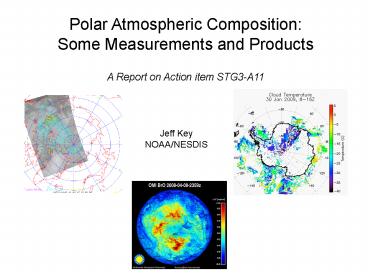Polar Atmospheric Composition:
1 / 14
Title:
Polar Atmospheric Composition:
Description:
Polar Atmospheric Composition: Some Measurements and Products A Report on Action item STG3-A11 Jeff Key NOAA/NESDIS Clouds AVHRR Polar Pathfinder extended (APP-x ... –
Number of Views:49
Avg rating:3.0/5.0
Title: Polar Atmospheric Composition:
1
Polar Atmospheric Composition Some Measurements
and Products A Report on Action item STG3-A11
Jeff Key NOAA/NESDIS
2
Clouds
3
AVHRR Polar Pathfinder extended (APP-x)
- Based on the NOAA/NASA AVHRR Polar Pathfinder
data set from NSIDC - Time period 1982 2004, 0400 1400 local
solar time. - Spatial scale 5 km, subsampled to 25 km over
the entire Arctic and Antarctic - Near real-time (once-daily) processing also
running - Parameters
- Surface temperature and albedo
- Cloud amount, phase, optical depth, particle
size, temperature, pressure - Surface and top-of-atmosphere shortwave and
longwave fluxes cloud forcing
4
NOAAs Operational AVHRR Cloud Product
- While advanced imagers such as VIIRS and ABI will
provide significantly improved cloud remote
sensing capabilities, the data from AVHRR and the
GOES imagers provide our best current real-time
cloud observing system from imager data. - The Clouds from AVHRR Extended System (CLAVR-x)
derives cloud properties from the AVHRR that are
physically similar to those from MODIS, VIIRS and
ABI and provide valuable experience to NOAAs
customers that should increase the usage of cloud
products during NPOESS and GOES-R. - Similar algorithms to those used in CLAVR-x are
run on GOES imager data and provide a consistent
suite of cloud products to NOAAs customers at
multiple spatial and temporal resolutions.
Example CLAVR-x Product at 55 km
Example CLAVR-x Product at 1 km
5
AVHRR Pathfinder Atmospheres Extended (PATMOS-x)
- PATMOS-x is continuation of the NESDIS PATMOS
program in the 1990s. The AVHRR is relevant
sensor for climate given its long record,
consistent spectral coverage and improving
calibration. - PATMOS-x offers new products at a higher
resolution from improved data. Where PATMOS only
offered cloud amount, PATMOS-x provides a full
suite of cloud properties and selected clear-sky
products. - PATMOS-x products were developed to be physically
consistent with those from EOS/MODIS. We are
trying to achieve same consistency with
NPOESS/VIIRS. - PATMOS-x leverages heavily off of the
development efforts already funded for real-time
product generation (i.e. CLAVR-x) - PATMOS-x speaks directly to the NOAA mission of
Climate Variability
Example Year to Year Variation in High Cloud
Amount from PATMOS-x
(Andy Heidinger)
6
Metop AVHRR Operational Clouds from NESDIS
- The Advanced Very High Resolution Radiometer
(AVHRR) on Metop, launched October 2006,
provides global 1km data for the first time from
an operational sensor. - The Clouds from AVHRR Extended (CLAVR-x)
processing system can generate 1 km cloud
products (detection, type, height, and optical
properties). - CLAVR-x transitioned to operational status in May
2007. - Since then, global 1 km cloud properties have
been produced operationally and made available to
NESDIS customers. - The images on the left show were generated from
CLAVR-x output for August 2, 2006 from METOP-A
FRAC data over Europe. - The image on the left shows a false image using
the 0.63, 0.86 and 11 mm observations. - The image on the right shows the cloud optical
depth. Values greater than 20 are shown as red.
Small values are blue. - Work is ongoing with EUMETSAT on METOP product
validation and inter-comparison.
False Color Image using 0.63, 0.86 and 11 mm
observations from METOP-A
Derived Cloud Optical Thickness from CLAVR-x
(Andy Heidinger)
7
MODIS Cloud Products Direct Broadcast and
Archived
In theory, the MODIS cloud detection scheme is
more robust than that for AVHRR, given more
spectral information with MODIS.
8
Atmospheric Chemistry and Aerosols
9
Atmospheric Composition and Aerosol Measurements
- Bromine (BrO) from OMI (on Aura) and GOME-2 (on
MetOP) - Total column ozone and NO2 from OMI (Aura) and
GOME-2 (MetOP) (daytime) - Tropospheric O3 and CO profiles from the
Tropospheric Emission Spectrometer (TES) - Tropospheric O3 and CO profiles from AIRS (Terra)
- Total column CO from MOPITT (Terra) and IASI
(Metop) - Stratospheric and upper tropospheric O3, CO, ClO,
HCl, HNO3 and SO2 profiles from the Microwave
Limb Sounder (MLS) (Aura) - Stratospheric O3, NO2, and aerosol extinction
from Optical Spectrograph and Infrared Imager
System (OSIRIS) on the Canadian ODIN satellite - A suite of molecules (including
O3,CH4,N2O,NO2,NO,HNO3,HCl,HF,CO) from the
Atmospheric Chemistry Experiment (ACE) FTS
onboard the Canadian SCISAT-1 satellite - Stratospheric O3 profiles from SBUV2 (daytime)
- Total column measurements of O3, NO2, OC1O, H2CO,
Br0 from SCIAMACHY on ENVISAT - Stratospheric profile measurements of O3, NO2,
BrO, H2O, N2O,CO, CH4 from SCIAMACHY on ENVISAT. - Aerosol attenuated backscatter from CALIPSO
- Aerosol Optical Depth from MODIS and MISR
(daytime, no ice/snow)
10
Total vertical column bromine (BrO) observations
from OMI (on Aura) and GOME-2 (on MetOP) for
2359Z and 1530Z (24-hr averages) on April 8,
2008. Arctic boundary layer BrO enhancements lead
rapid ozone loss within the Arctic boundary layer.
OMI data provided by Thomas Kurosu,
Harvard-Smithsonian Center for Astrophys. GOME-2
data provided by Trevor Beck, NOAA/NESDIS
11
Winds and Soundings
12
Polar Winds from MODIS and AVHRR
MODIS bent-pipe, MODIS direct broadcast, Terra
Aqua separately and combined AVHRR GAC, HRPT,
NOAA MetOp (with EUMETSAT) satellites
historical GAC
13
Soundings from TOVS Path-P
- Arctic TOVS-derived Level-3 atmospheric
parameters are obtained using a
physical-statistical retrieval method, improved
for use in sea ice-covered areas (J. Francis).
Parameters - Air temperature
- Effective cloud amount/frequency
- Cloud top pressure
- Cloud top temperature
- Cloud emissivity
- Precipitable Water
- Skin temperature
- Surface air temperature
- Wind stress
- Period
- NH 1979 2005
- SH 1979 2001
- (no retrievals for land gt 1000 m elev)
14
Hyperspectral Global Soundings
Global hyperspectral atmospheric soundings are
available from NASAs AIRS instrument and
EUMETSATs IASI. These should improve soundings
in the polar regions, particularly in the lower
troposphere where temperature inversions are
common.
NAST-I spectrum over Oklahoma, 3 March 2000.































